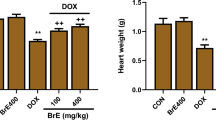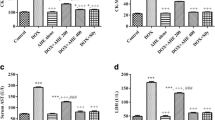Abstract
Purpose
Doxorubicin (DOX) is a highly active antineoplastic agent; however, its clinical use is limited due to associated cardiotoxicity. This study was performed to evaluate the beneficial effects of allicin, a dietary garlic active constituent against DOX-induced cardiotoxicity.
Methods
Forty male Swiss albino mice were divided into five groups, which received normal saline, oral allicin (20 mg kg−1 once daily), intraperitoneal DOX (on the 7, 9 and 11th day of the experiment), or DOX plus once daily allicin at 10 or 20 mg kg−1. Sera were collected for evaluation of cardiac injury markers and proinflammatory cytokines. Additionally, heart tissue spacemen were harvested for determination of oxidative stress markers, as well as for histopathological examination and immunohistochemical analysis.
Results
DOX administration induced significant (p < 0.05) reductions in cardiac tissue level of reduced glutathione and activities of antioxidant enzymes (catalase, superoxide dismutase, and glutathione peroxidase). Moreover, it induced significant (p < 0.05) elevations in cardiac tissue concentrations of nitric oxide and malondialdehyde as well as serum levels of cardiac injury biomarkers (lactate dehydrogenase, creatine kinase, and creatine kinase-MB) and proinflammatory cytokines (interleukin-1β, and tumor necrosis factor-alpha). The histopathological examination showed necrotic and degenerative changes in the cardiac tissue, while immunohistochemical analysis revealed marked myocardial expression of activated caspase-3 and cyclooxygenase-2, following DOX adminstration. Allicin pretreatment significantly improved (p < 0.05) all examined parameters, and restored the cardiac architecture.
Conclusion
The current study demonstrated that allicin effectively mitigates cardiac oxidative damage, apoptosis and inflammation, induced by acute DOX intoxication. Therefore, allicin could be a promising cytoprotective agent against DOX cardiotoxicity.




Similar content being viewed by others
Abbreviations
- CAT:
-
Catalase
- CK:
-
Creatine kinase
- CK-MB:
-
Creatine kinase-myocardial B fraction
- COX2:
-
Cyclo-oxygenase-2
- DOX:
-
Doxorubicin
- GPx:
-
Glutathione peroxidase
- GSH:
-
Glutathione
- LDH:
-
Lactate dehydrogenase
- IL-1β:
-
Interleukin-1β
- MDA:
-
Malondialdehyde
- NO:
-
Nitric oxide
- 8-OHdG:
-
8-Oxo-2′-deoxyguanosine
- SOD:
-
Superoxide dismutase
- TNF:
-
Tumor necrosis factor
References
Injac R, Perse M, Obermajer N, Djordjevic-Milic V, Prijatelj M et al (2008) Potential hepatoprotective effects of fullerenol C60(OH)24 in doxorubicin-induced hepatotoxicity in rats with mammary carcinomas. Biomaterials 29:3451–3460
Berthiaume JM, Wallace KB (2007) Adriamycin-induced oxidative mitochondrial cardiotoxicity. Cell Biol Toxicol 23:15–25
Hao G, Yu Y, Gu B, Xing Y, Xue M (2015) Protective effects of berberine against doxorubicin-induced cardiotoxicity in rats by inhibiting metabolism of doxorubicin. Xenobiotica 45(11):1024–1029
Olson RD, Boerth RC, Gerber JG, Nies AS (1981) Mechanism of adriamycin cardiotoxicity: evidence for oxidative stress. Life Sci 29:1393–1401
Octavia Y, Tocchetti CG, Gabrielson KL, Janssens S, Crijns HJ et al (2012) Doxorubicin-induced cardiomyopathy: from molecular mechanisms to therapeutic strategies. J Mol Cell Cardiol 52:1213–1225
Li DL, Wang ZV, Ding G, Tan W, Luo X et al (2016) Doxorubicin blocks cardiomyocyte autophagic flux by inhibiting lysosome acidification. Circulation 133:1668–1687
Ky B, Vejpongsa P, Yeh ET, Force T, Moslehi JJ (2013) Emerging paradigms in cardiomyopathies associated with cancer therapies. Circ Res 113:754–764
Oz E, Ilhan MN (2006) Effects of melatonin in reducing the toxic effects of doxorubicin. Mol Cell Biochem 286:11–15
Deepa PR, Varalakshmi P (2005) Biochemical evaluation of the inflammatory changes in cardiac, hepatic and renal tissues of adriamycin-administered rats and the modulatory role of exogenous heparin-derivative treatment. Chem Biol Interact 156:93–100
Abushouk AI, Ismail A, Salem AMA, Afifi AM, Abdel-Daim MM (2017) Cardioprotective mechanisms of phytochemicals against doxorubicin-induced cardiotoxicity. Biomed Pharmacother 90:935–946
Bordia A, Verma S, Vyas A, Khabya B, Rathore A et al (1977) Effect of essential oil of onion and garlic on experimental atherosclerosis in rabbits. Atherosclerosis 26:379–386
Reinhart KM, Coleman CI, Teevan C, Vachhani P, White CM (2008) Effects of garlic on blood pressure in patients with and without systolic hypertension: a meta-analysis. Ann Pharmacother 42:1766–1771
Elkayam A, Peleg E, Grossman E, Shabtay Z, Sharabi Y (2013) Effects of allicin on cardiovascular risk factors in spontaneously hypertensive rats. Isr Med Assoc J 15:170–173
Sun X, Ku DD (2006) Allicin in garlic protects against coronary endothelial dysfunction and right heart hypertrophy in pulmonary hypertensive rats. Am J Physiol Heart Circ Physiol 291:H2431–H2438
Suddek GM (2014) Allicin enhances chemotherapeutic response and ameliorates tamoxifen-induced liver injury in experimental animals. Pharm Biol 52:1009–1014
Chan JY, Tsui HT, Chung IY, Chan RY, Kwan YW et al (2014) Allicin protects rat cardiomyoblasts (H9c2 cells) from hydrogen peroxide-induced oxidative injury through inhibiting the generation of intracellular reactive oxygen species. Int J Food Sci Nutr 65:868–873
Zhang L, Wang E, Chen F, Yan H, Yuan Y (2013) Potential protective effects of oral administration of allicin on acrylamide-induced toxicity in male mice. Food Funct 4:1229–1236
El-Kashef DH, El-Kenawi AE, Suddek GM, Salem HA (2015) Protective effect of allicin against gentamicin-induced nephrotoxicity in rats. Int Immunopharmacol 29:679–686
Abdel-Daim MM, Abdelkhalek NK, Hassan AM (2015) Antagonistic activity of dietary allicin against deltamethrin-induced oxidative damage in freshwater Nile tilapia; Oreochromis niloticus. Ecotoxicol Environ Saf 111:146–152
Ashry NA, Gameil NM, Suddek GM (2013) Modulation of cyclophosphamide-induced early lung injury by allicin. Pharm Biol 51:806–811
Pecoraro M, Del Pizzo M, Marzocco S, Sorrentino R, Ciccarelli M et al (2016) Inflammatory mediators in a short-time mouse model of doxorubicin-induced cardiotoxicity. Toxicol Appl Pharmacol 293:44–52
Reitman S, Frankel S (1957) A colorimetric method for the determination of serum glutamic oxalacetic and glutamic pyruvic transaminases. Am J Clin Pathol 28:56–63
Babson SR, Babson AL (1973) An improved amylase assay using dyed amylopectin. Clin Chim Acta 44:193–197
Szasz G, Waldenstrom J, Gruber W (1979) Creatine kinase in serum: 6. Inhibition by endogenous polyvalent cations, and effect of chelators on the activity and stability of some assay components. Clin Chem 25:446–452
Wurzburg U, Hennrich N, Lang H, Prellwitz W, Neumeier D et al (1976) Determination of creatine kinase-MB in serum using inhibiting antibodies (author’s transl). Klin Wochenschr 54:357–360
Aebi H (1984) Catalase in vitro. Methods Enzymol 105:121–126
Nishikimi M, Appaji N, Yagi K (1972) The occurrence of superoxide anion in the reaction of reduced phenazine methosulfate and molecular oxygen. Biochem Biophys Res Commun 46:849–854
Paglia DE, Valentine WN (1967) Studies on the quantitative and qualitative characterization of erythrocyte glutathione peroxidase. J Lab Clin Med 70:158–169
Beutler E, Duron O, Kelly BM (1963) Improved method for the determination of blood glutathione. J Lab Clin Med 61:882–888
Mihara M, Uchiyama M (1978) Determination of malonaldehyde precursor in tissues by thiobarbituric acid test. Anal Biochem 86:271–278
Green LC, Wagner DA, Glogowski J, Skipper PL, Wishnok JS et al (1982) Analysis of nitrate, nitrite, and [15 N] nitrate in biological fluids. Anal Biochem 126:131–138
Ahmed HH, Mannaa F, Elmegeed GA, Doss SH (2005) Cardioprotective activity of melatonin and its novel synthesized derivatives on doxorubicin-induced cardiotoxicity. Bioorg Med Chem 13:1847–1857
De Beer EL, Bottone AE, Voest EE (2001) Doxorubicin and mechanical performance of cardiac trabeculae after acute and chronic treatment: a review. Eur J Pharmacol 415:1–11
Zhou S, Starkov A, Froberg MK, Leino RL, Wallace KB (2001) Cumulative and irreversible cardiac mitochondrial dysfunction induced by doxorubicin. Cancer Res 61:771–777
Ascensao A, Magalhaes J, Soares JM, Ferreira R, Neuparth MJ et al (2005) Moderate endurance training prevents doxorubicin-induced in vivo mitochondriopathy and reduces the development of cardiac apoptosis. Am J Physiol Heart Circ Physiol 289:H722–H731
Fang YZ, Yang S, Wu G (2002) Free radicals, antioxidants, and nutrition. Nutrition 18:872–879
Griffith OW (1999) Biologic and pharmacologic regulation of mammalian glutathione synthesis. Free Radic Biol Med 27:922–935
Raskovic A, Stilinovic N, Kolarovic J, Vasovic V, Vukmirovic S et al (2011) The protective effects of silymarin against doxorubicin-induced cardiotoxicity and hepatotoxicity in rats. Molecules 16:8601–8613
Hou XW, Jiang Y, Wang LF, Xu HY, Lin HM et al (2009) Protective role of granulocyte colony-stimulating factor against adriamycin induced cardiac, renal and hepatic toxicities. Toxicol Lett 187:40–44
Wang GY, Wang YM, Zhang LN, Li Q, Yue H et al (2007) Effect of resveratrol on heart function of rats with adriamycin-induced heart failure. Zhongguo Zhong Yao Za Zhi 32:1563–1565
Aniss HA, Said Ael M, El Sayed IH, Adly C (2014) Amelioration of adriamycin-induced cardiotoxicity by Salsola kali aqueous extract is mediated by lowering oxidative stress. Redox Rep 19:170–178
Yilmaz S, Atessahin A, Sahna E, Karahan I, Ozer S (2006) Protective effect of lycopene on adriamycin-induced cardiotoxicity and nephrotoxicity. Toxicology 218:164–171
Palmeira CM, Serrano J, Kuehl DW, Wallace KB (1997) Preferential oxidation of cardiac mitochondrial DNA following acute intoxication with doxorubicin. Biochim Biophys Acta 1321:101–106
Rabinkov A, Miron T, Mirelman D, Wilchek M, Glozman S et al (2000) S-Allylmercaptoglutathione: the reaction product of allicin with glutathione possesses SH-modifying and antioxidant properties. Biochim Biophys Acta 1499:144–153
Rabinkov A, Miron T, Konstantinovski L, Wilchek M, Mirelman D et al (1998) The mode of action of allicin: trapping of radicals and interaction with thiol containing proteins. Biochim Biophys Acta 1379:233–244
Prasad K, Laxdal VA, Yu M, Raney BL (1995) Antioxidant activity of allicin, an active principle in garlic. Mol Cell Biochem 148:183–189
Wong J, Smith LB, Magun EA, Engstrom T, Kelley-Howard K et al (2013) Small molecule kinase inhibitors block the ZAK-dependent inflammatory effects of doxorubicin. Cancer Biol Ther 14:56–63
Tangpong J, Cole MP, Sultana R, Estus S, Vore M et al (2007) Adriamycin-mediated nitration of manganese superoxide dismutase in the central nervous system: insight into the mechanism of chemobrain. J Neurochem 100:191–201
Okada Y, Tanaka K, Sato E, Okajima H (2006) Kinetic and mechanistic studies of allicin as an antioxidant. Org Biomol Chem 4:4113–4117
Liu C, Cao F, Tang Q-Z, Yan L, Dong Y-G et al (2010) Allicin protects against cardiac hypertrophy and fibrosis via attenuating reactive oxygen species-dependent signaling pathways. J Nutr Biochem 21:1238–1250
Chatterjee K, Zhang J, Tao R, Honbo N, Karliner JS (2008) Vincristine attenuates doxorubicin cardiotoxicity. Biochem Biophys Res Commun 373:555–560
Shi J, Zhang L, Zhang Y-W, Surma M, Payne RM et al (2012) Downregulation of doxorubicin-induced myocardial apoptosis accompanies postnatal heart maturation. Am J Physiol Heart Circ Physiol 302:H1603–H1613
Yalçin E, Oruç E, Çavuşoğlu K, Yapar K (2010) Protective role of grape seed extract against doxorubicin-induced cardiotoxicity and genotoxicity in albino mice. J Med Food 13:917–925
Boucek RJ Jr, Miracle A, Anderson M, Engelman R, Atkinson J et al (1999) Persistent effects of doxorubicin on cardiac gene expression. J Mol Cell Cardiol 31:1435–1446
Singh G, Singh AT, Abraham A, Bhat B, Mukherjee A et al (2008) Protective effects of Terminalia arjuna against doxorubicin-induced cardiotoxicity. J Ethnopharmacol 117:123–129
Takemura G, Fujiwara H (2007) Doxorubicin-induced cardiomyopathy: from the cardiotoxic mechanisms to management. Prog Cardiovasc Dis 49:330–352
Davitashvili D, Museridze D, Svanidze I, Gegenava L, Sanikidze T (2009) Investigation of oxidative stress-induced alterations in the rat brain cortical cellular culture and their correction with vitamins E and C. Georgian Med News 177:73–77
Waring P (2005) Redox active calcium ion channels and cell death. Arch Biochem Biophys 434:33–42
Author information
Authors and Affiliations
Corresponding author
Ethics declarations
Conflict of interest
All authors declare no related conflicts of interest.
Funding sources
This research work received no funding from any organization.
Ethical approval
This manuscript include animal experiments, and the animal handling, housing and care, as well as the experimental protocol were approved by Animal Care and Ethics Review Committee at the Faculty of Veterinary Medicine, Suez Canal University, Ismailia, Egypt (The Approval No. 201609). This article does not contain any studies with human participants performed by any of the authors.
Rights and permissions
About this article
Cite this article
Abdel-Daim, M.M., kilany, O.E., Khalifa, H.A. et al. Allicin ameliorates doxorubicin-induced cardiotoxicity in rats via suppression of oxidative stress, inflammation and apoptosis. Cancer Chemother Pharmacol 80, 745–753 (2017). https://doi.org/10.1007/s00280-017-3413-7
Received:
Accepted:
Published:
Issue Date:
DOI: https://doi.org/10.1007/s00280-017-3413-7




